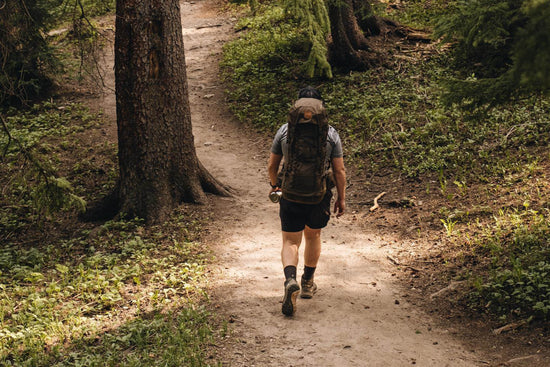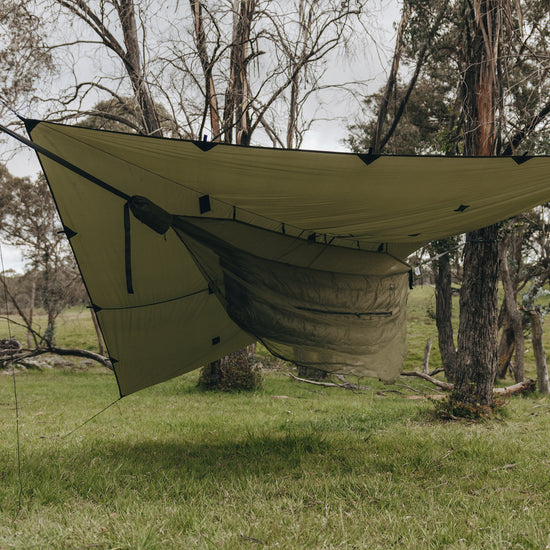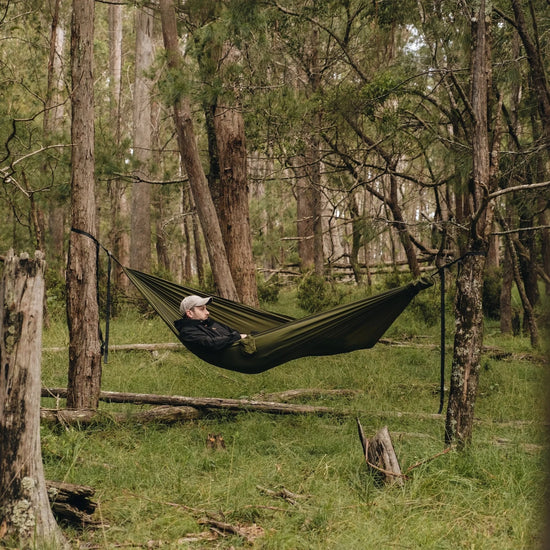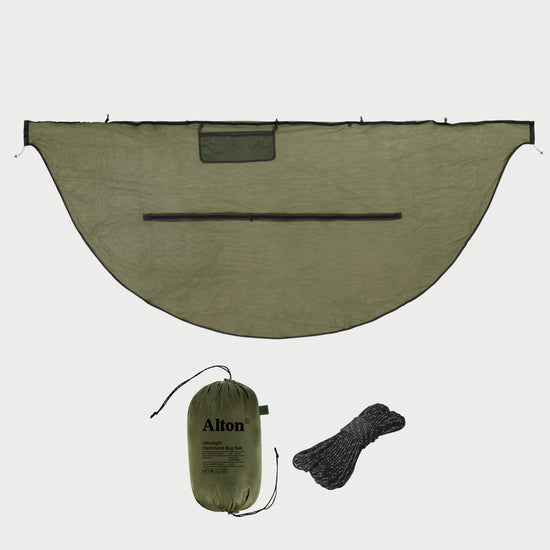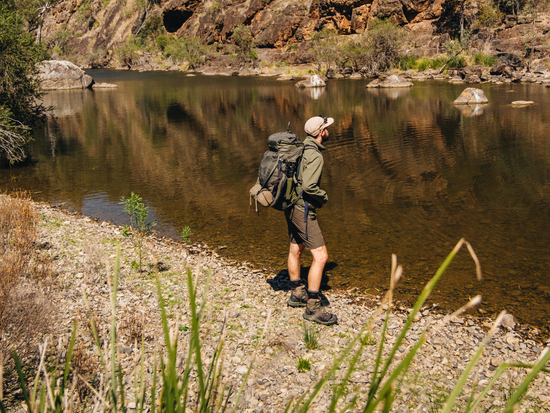Camping hammocks have been gaining popularity over the past few years as an alternative shelter option for camping. Why? Well, there are a lot of reasons why hammock camping is great. But, one of the biggest reasons by far is comfort.
In this blog, we’ll take you through our expert tips for improving your camping hammock comfort so you can sleep better in the wild.
Why are camping hammocks so comfortable?
Do a quick online search and you’ll find some bold claims about hammocks out there, ranging from falling asleep faster to reducing back pain to curing insomnia. Interestingly, scientific studies appear to back up some of these claims around hammocks improving sleep, finding that the gentle swaying motion may promote deeper sleep. Whatever you make of all that, one thing is clear. A lot of people find camping hammocks to be exceptionally comfortable.
But, there is a catch. If you don’t know how to optimise your camping hammock for comfort, then you may be disappointed (and uncomfortable). Improper setup can make your hammock too taut or too saggy, making it impossible to get comfy.
Our top hammock camping comfort tips
With these expert hammock camping comfort tips, you’ll be able to avoid the dreaded ‘banana position' and get the most out of your camping hammock on your next overnight adventure.
1. Choose the right camping hammock for you
This sounds way too obvious, but a lot of people neglect to consider this when first starting out with hammock camping. You want a camping hammock that is long enough for you to lie comfortably. A good rule of thumb is to look for a hammock that is at least 60-90 cm longer than your height.
If you are very tall or have a large frame, a wider hammock will be beneficial, so consider going for a double sized hiking hammock. But, before you get carried away looking for the biggest hammock you can find, remember that weight is equally important to consider.

2. Choose an easy-to-use camping hammock suspension system
As well as simplifying the setup and takedown process, a good suspension system lets you have more flexibility. You’ll be able to adapt to a greater range of hanging locations without compromising on your comfort.
Look for a suspension strap system with multiple attachment points or loops that allow you to adjust the hanging height of your hammock. This makes it easy to adjust your hammock according to your preferences. As always, choose tree-friendly straps made from robust materials that will provide you with a safe and secure hang.
3. Do your research to find suitable locations
Alright, we can almost hear you thinking, “but, what does location have to do with comfort, Alton?” – and the answer is A LOT.
If the location you’re camping in doesn’t have suitable anchors, such as trees, rocks or even vehicles, to attach your camping hammock to, then you are probably going to be in for a long (and uncomfortable) night.
A quick online search can provide you with valuable information about the location you have in mind. Even if you can’t find specific recommendations from other hammock campers, you may be able to find pictures of the location that will reveal more.
4. Learn how to properly set up your hammock
When you first start out, it does take a little time and effort to learn how to set up your hammock. We’ve put together a handy guide on how to set up your camping hammock which goes into more detail, but here are some of the key setup considerations to keep in mind.
Start by selecting anchor points, such as trees, that are 60-80cm longer than the length of your hammock when it's fully stretched out. A good suspension system can give you more flexibility, but where possible, try to find anchors that are about 4m apart.
Then, attach suspension straps to your anchor points about 1.2- 1.6m up off the ground. You are aiming to have the lowest point of your hammock at a height where you can get in and out easily.
The exact height you’ll need to attach your straps will depend on your height and the amount of stretch in your hammock material and cordage. We suggest making note of the specific setup measurements that provide you with the most comfort so that you can easily replicate it on your next adventure.
5. Get technical about tension
This comfort tip goes hand in hand with the last. After selecting your anchor points and securing your suspension straps, it is time to attach your camping hammock.
You want the perfect amount of tension so that your hammock isn’t too saggy or taut. For most hammock campers, this is a 30º angle. To achieve this, adjust your hammock by tightening or loosening your suspension straps until they descend at a 30º angle from your anchor points.
A quick way to check the angle of your suspension straps is by using your hand. Make a ‘finger-gun’ shape, then placing your hand beneath the strap with your thumb closest to the anchor point. If the strap touches both the tip of your thumb and your pointer finger, your straps are approximately at a 30º angle.

6. Use a structural ridgeline with your camping hammock
To consistently achieve the ideal amount of sag in your hammock, consider using a structural ridgeline. A hammock ridgeline is a strong cord or rope that runs from one side of the hammock to the other, connected to your suspension straps. By giving you set points to attach your hammock, you are able to achieve the same amount of ‘sag’ every time you set up your hammock.
If you decide to try this out, be sure to use something that is strong enough to support your weight, such as 550 Paracord, or opt to purchase a purpose-made structural ridgeline for hammock camping. Adjust your ridgeline to be 83% to 85% of the total hammock length until the hammock is suspended at a 30º angle.
7. Lower the head-side of your camping hammock
When setting up your hammock straps, try lowering the end of your camping hammock where you will have your head resting 15-25 cm lower than the feet-side. Setting the head-side lower prevents you from sliding into the centre of the hammock, allowing you to sleep in a flatter position.
8. Lie at a diagonal across your camping hammock
Setup is done and now it’s time to get into your camping hammock. Position yourself at a slight diagonal angle across the hammock. Just like our last suggestion, positioning yourself on a diagonal helps hold your body in a flatter position for increased comfort.
9. Stay warm with the right camping hammock insulation
Planning a hammock camping trip in cold, winter conditions? A sleeping bag may not be enough insulation to keep you warm in a camping hammock.
Suspended in a camping hammock, you are exposed to the air around you, causing you to lose more body heat compared to sleeping in a tent. To mitigate this, you’ll need a hammock-specific insulation strategy.
As well as a top-quilt or sleeping bag, a purpose-made hammock underquilt will give you the most effective insulation against the cold. Resting underneath your hammock and around the sides, it forms a cosy insulative cocoon. Some hikers also use a closed-cell foam mat or an insulated air mattress beneath them for maximum warmth.

10. Find your camping hammock ‘sweet spot’
Now you’ve got all the tips for optimum camping hammock comfort, it is time to find your ‘sweet spot’, as the camping hammock community likes to say. This mythical sweet spot is where you feel totally supported and ultra comfortable.
To find yours, try taking your hammock for a test run before you have your first adventure in the wild. Experiment with your setup and sleeping position. Keep testing and tweaking things until you find the ideal configurations to suit your body.
That’s a wrap!
With these comfort-enhancing tips, you’ll be able to get the most out of your hammock camping adventures. Let us know how you went putting these in practice in the wild, or if you have any other hammock camping comfort hacks to share!


